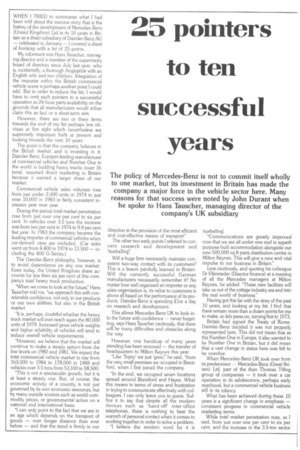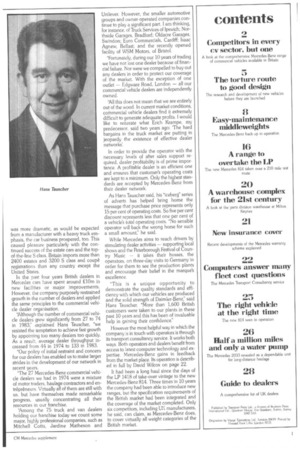25 pointers to ten successful years
Page 126

Page 127

If you've noticed an error in this article please click here to report it so we can fix it.
WHEN I TRIED to summarise what I had been told about the success story that is the history of the development of Mercedes-Benz (United Kingdom) Ltd in its 10 years in Britain as a direct subsidiary of Daimler-Benz AG — celebrated in January — I covered a sheet of foolscap with a list of 25 points.
My informant was Hans Tauscher, managing director and a member of the supervisory board of directors since July last year, who is, incidentally, a thorough Anglophile with an English wife and two children. Integration of the importer within the British commercial vehicle scene is perhaps another point I could add. But in order to reduce the list, I would have to omit such pointers to a successsful operation as 24-hour parts availability on the grounds that all manufacturers would either claim this as fact or a short-term aim.
However, there are two or three items towards the end of my list perhaps less obvious at first sight which nevertheless are supremely important both at present and looking towards the next 10 years.
The point is that the company believes in the British market and is investing in it. Daimler-Benz. Europe's leading manufacturer of commercial vehicles and Number One in the world in building heavy trucks (over 16 tons), resumed direct marketing in Britain because it wanted a larger share of our market.
Commercial vehicle sales volumes rose from just under 2,000 units in 1974 to just over 10,000 in 1983 in fairly consistent increases year over year.
During this period total market penetration rose from just over one per cent to six per cent. In vehicles over 3.5 tons the increase was from two per cent in 1974 to 9.8 per cent last year. In 1983 the company became the leading importer of commercial vehicles when car-derived vans are excluded. (Car sales went up from 4,400 in 1974 to 13,500 — including the 400 G-Series.) The Damiler-Benz philosphy, however, is to avoid dependence on any one market. Even today, the United Kingdom share accounts for less than six per cent of this company's total heavy truck production.
"When we come to look at the future," Hans Tauscher told me, "we approach this with considerable confidence, not only in our products or our own abilities, but also in the British market.
it is, perhaps, doubtful whether the heavy truck market will ever reach again the 80,000 units of 1979. Increased gross vehicle weights and higher reliability of vehicles will tend to reduce overall vehicle requirements.
"However, we believe that the market will continue to make a steady upturn from the low levels on 1980 and 1981. We expect the total commercial vehicle market to rise from 163,000 in 1984to 178,000 in 1988 and vehicles over 3.5 tons from 53,100 to 58,500.
"This is not a spectacular growth, but it is at least a steady one. But, of course, the economic activity of a country is not just governed by its own economic resources, but by many outside sources such as world commodity prices, or governmental action on a national and international basis.
"I can only point to the fact that we are in an age which depends on the transport of goods — over longer distance than ever before — and that the trend is firmly in our direction in the provision of the most efficient and cost-effective means of transport!"
The other two early points I referred to concern research and development and "eyeballing".
Will a huge firm necessarily maintain consistent two-way contact with its customers? This is a lesson painfully learned in Britain. Will the currently successful German manufacturers necessarily remember it? No matter how well organised an importer or any sales organisation is, its value to customers is above all based on the performance of its products. Daimler-Benz is spending Elm a day on research and development.
This allows Mercedes-Benz UK to look into the future with confidence — never forgetting, says Hans Tauscher cautiously, that there will be many difficulties and obstacles along the way.
However, one handicap of many years standing has been removed — the transfer of headquarters to Milton Keynes this year.
"Like 'Topsy' we just 'grew'," he said, "from the very small premises we occupied in Brentford, when I first joined the company.
"In the end, we occupied seven locations spread around Brentford and Hayes. What this means in terms of stress and frustration in trying to communicate effectively with colleagues, I can only leave you to guess. Suffice it to say that despite all the modern devices such as 'hand-off inter-office telephones, there is nothing to beat the warmth of personal contact when it comes to working together in order to solve a problem.
"I believe the modern word for it is 'eyeballing'.
"Communications are greatly improved now that we are all under one roof in superb purpose-built accommodation alongside our new 500,000 sq ft parts distribution centre in Milton Keynes. This will give a new and vital impulse to our business in Britain?'
Less cautiously, and quoting his colleague Dr Ellenrieder (Director-finance) at a meeting of all the Mercedes managers at Milton Keynes, he added: "These new facilities will take us out of the cottage industry era and into the real world of business?'
Having got this far with the story of the past 10 years, and looking at my list, I find that there remain more than a dozen points for me to make, so let's press on, turning first to 1973.
Britain had signed the Treaty of Rome. Daimler-Benz decided it was not properly represented here. This did not mean that as the Number One in Europe, it also wanted to be Number One in Britain, but it did mean that a vast change in status here-was felt to be overdue.
When Mercedes-Benz UK took over from its predecessor — Mercedes-Benz (Great Britain) Ltd, part of the then Thomas Tilling group of companies — it took over a car operation in its adolescence, perhaps early manhood, but a commercial vehicle business still in its infancy.
What has been achieved during these 10 years is a significant change in emphasis — consistent progress in commercial vehicle marketing terms.
While total market penetration rose, as I said, from just over one per cent to six per cent, and the increase in the 3.5-ton sector was more dramatic, as would be expected from a manufacturer with a heavy truck emphasis, the car business prospered, too. This caused pleasure particularly with the continued success of the estate cars and the topof-the-line S class. Britain imports more than 2400 estates and 3200 S class and coupe registrations than any country except the United States.
In the past four years British dealers in Mercedes cars have spent around £10m in new facilities or major improvements. However, the company purposely restrained growth in the number of dealers and applied the same principles to the commercial vehicle dealer organisation.
"Although the number of commercial vehicle dealers grew significantly from 27 to 74 in 1983: explained Hans Tauscher, "we resisted the temptation to achieve fast growth by appointing too many dealers too quickly. As a result, average dealer throughput increased from 44 in 1974 to 133 in 1983.
"Our policy of initial restraint and concern for our dealers has enabled us to make larger strides in the development of our network in recent years.
"The 27 Mercedes-Benz commercial vehicle dealers we had in 1974 were a mixture of motor traders, haulage contractors and entrepreneurs. Virtually all of them are still with us, but have themselves made remarkable progress, usually concentrating all their resources in our franchise, "Among the 75 truck and van dealers holding our franchise today we count some major, highly professional companies, such as Mitchell Cotts, Jardine Matheson and Unilever. However, the smaller automotive groups and owner-operated companies continue to play a significant part. I am thinking, for instance, of Truck Services of Ipswich; Northside Garages, Bradford; Oldacre Garages, Swindon; Euro Commercials, Cardiff; Isaac Agnew, Belfast; and the recently opened facility of WSM Motors, of Bristol.
"Fortunately, during our 10 years of trading we have not lost one dealer because of financial failure. Nor were we compelled to buy out any dealers in order to protect our coverage of the market. With the exception of one outlet — Edgware Road, London — all our commercial vehicle dealers are independently owned.
"All this does not mean that we are entirely out of the wood. In current market conditions, coinnnercial vehicle dealers find it extremely difficult to generate adequate profits. I would like to reiterate what Erich Krarnpe, my predecessor, said two years ago: 'The hard bargains in the truck market are putting in jeopardy the existence of effective dealer networks'.
In order to provide the operator with the necessary levels of after sales support required, dealer profitability is of prime importance. A profitable dealer is an efficient one and ensures that customer's operating costs are kept to a minimum. Only the highest standards are accepted by Mercedes-Benz from their dealer network.
As Hans Tauscher said, his "iceberg" series of adverts has helped bring home the message that purchase price represents only 15 per cent of operating costs. So five per cent discount represents less that one per cent of a vehicle's total operating costs. "No sensible operator will back the wrong horse for such a small amount," he said.
While Mercedes aims to reach drivers by stimulating dealer activities — supporting local shows and the Peterborough Festival of Country Music -it takes their bosses, the operators, on three-day visits to Germany in order for them to see the production plants and encourage their belief in the marque's excellence.
"This is a unique opportunity to demonstrate the quality standards and efficiency with which our vehicles are produced and the solid strength of Daimler-Benz: said Hans Tauscher. "More than 1,600 British customers were taken to our plants in these past 10 years and this has been of invaluable help in gaining their confidence."
However the most helpful way in which the company is in touch with operators is through its transport consultancy service. It works both ways. Both operators and dealers benefit from access to latest computer technology and expertise. Mercedes-Benz gains in feedback from the market place. Its operation is described in full by David Wilcox on page 22.
It had been a long haul since the days of the LP 1418 of take-over vintage to the new Mercedes-Benz 814. Three times in 10 years the company had been able to introduce new ranges, but the specification requirements of the British market had been integrated and the coverage of the market completed. Only six competitors, including Urs manufacturers, he said, can claim, as Mercedes-Benz does, to cover virtually all weight categories of the British market.




























































































































































